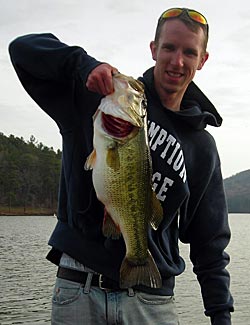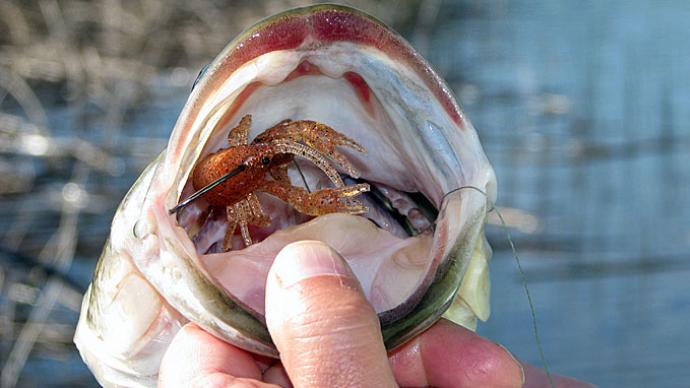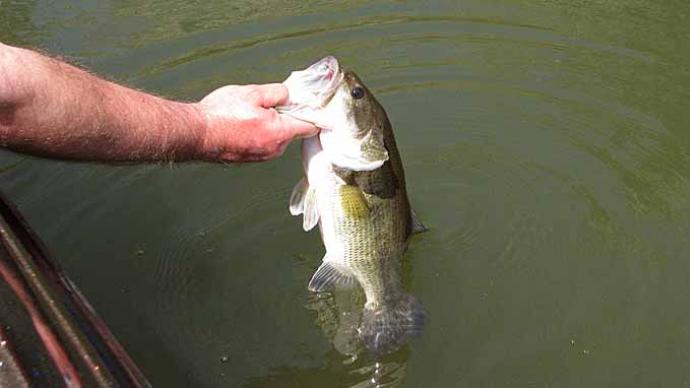
The fall season is really a transitional time for bass and we often can let ourselves get fooled into thinking the conditions we perceive above water as having the same immediate impact in the water. As in the spring, our best tools in trying to figure out where the bass are in the fall, and why they are there, are a temperature gauge used in conjunction with a depth finder. In fact in most of Texas we really have three distinct stages of fall patterns.
The first occurs in the part of fall in which there is really little difference with afternoon temperatures from those of late summer. In some years this period can extend until the first appreciable cold front of mid or late October. The difference that makes this period unlike summer is the unavoidable lengthening of the nights. Even with hot daytime temperatures, the longer, cooler nights have several affects. These include causing the water temperature to begin to drop. The impact will begin to occur more noticeably in back-ups or shores, which have the least exposure to the hotter afternoon sun. Evidence of this effect may not be apparent to us, but it signals a coming change of season to bass.
The other aspect of shorter days is to trigger the instinct of animals that a change is coming, and this does not necessarily have anything to do with daytime temperatures.
During the summer, bass often have become organized on larger lakes into varying size schools. These bass stage in given areas where there are concentrations of the number one summer food source - shad. These areas are also usually associated with some sort of structure. The bass that have been schooling in a given area of a lake often tend to gradually drop their daily periods of schooling activity back to later periods during the day as the nights begin to lengthen. It is not uncommon once the mid-stage of fall occurs (once the first fronts of October have actually made it through), on lakes where schooling activity occurred most of the day in the late summer to find that the bass are only aggressively breaking on shad in the late afternoon (after the effect is felt of the afternoon sun). In fact I have seen this carried to the extreme example on several lakes when in the last hour of the day the fish suddenly began to break where none had shown signs of chasing anything during the day. These were not flukes since the same pattern would occur late in the season for several weeks until a major front shut it down.
The impact of the cooling effects of the longer nights trigger bass in many lakes to begin a shift or migration. This movement is toward the back of coves, up creeks, or to a shallower staging area. The shad also tend to make similar shifts at this time that probably plays a large role as an additional attraction for the bass to make their move. I make this point regarding shad because they are still the main forage bait for bass in most major reservoirs during the two earliest phases of fall. Because of this very fact, crankbaits are particularly lethal for finding schools of bass in the early and mid-fall periods. Since the schools are working on shad, this message should therefore tell you that the bait color most productive will be silver chrome, bone, or white. A lipless crank such as a Rat-L-Trap or Hot Spot is particularly lethal during the fall.
The other thing to remember when fishing in the fall is that while you can still get more hits on smaller plugs, you will catch larger fish on larger baits. During the fall the food sources that hatched in the spring including the baitfish, have reached a more mature size so you can afford to throw a larger bait. Another advantage the bass fisherman has in the fall is that the water temperature is still warm thus a feeding bass will tend to have a larger strike zone than that same fish will often have in the colder water of winter.
Topwater baits are also ideal lures to work in the fall periods. If you go back to the concept that most potential food sources have reached a more mature stage and size then it follows that a large topwater such as a Zara Spook should, and will, get strikes. The place to present a topwater during the fall is not only in shallower water or along banks or vegetation, but fishing them over deeper water brush will also produce.
The buzz word in fall patterns is shallower and while in most cases we tend to think toward shallower water, it can also mean deeper water bass rising to a shallower strata in standing cover such as flooded brush or trees. If you think about it, a buzzbait is actually a cross between a crank and a topwater bait. If bass feed actively for longer periods during the fall and have a larger strike zone then it is not a surprise as to why a buzzbait gets plenty of attention from fall bass. Bass will tend to respond during midday periods in response to the degree of brightness. If the fish are not moving during a very bright day, you likely will have to shift to a soft plastic to get strikes during midday. However, in the fall even these baits will often be successfully fished in considerably shallower water than you would have fished them during midday in the summer.
A variation with summertime fishing also occurs in that during the fall bass will tend to be shallower for longer periods. They will also tend to be more active for longer periods during cloudy days, and often do not drop back to deeper midday holding areas at all. A cloudy day in the fall often means big-time action all day long and in the same area early to late. A good rule of thumb is: the more stained the water, the shallower the bass may be during fall patterns.
During mid- and late fall, the use of a temperature gauge is critical. What we feel as air temperature has nothing to do with water temperature. At least the effect of air temperature should be remembered to require sustained periods of lower temperature to really drive the water temperature appreciably downward toward the wintertime lows. I have caught bass on topwaters in Rayburn and Toledo Bend when I was wearing a windbreaker and sweatshirt. The water temperature was still in the mid-70's and the fish did not mind one bit breaking on a chugger. It is not that much of exaggeration to remember the advice I was given by a longtime bass fisherman who told me that if the surface warms enough in the afternoon for turtles to sun themselves, you can catch some shallower strata bass.
There is one other variation which begins to occur in the late fall and that is the effect on the pattern of bass becomes more dramatic with the passage of each major cold front. While the passage of early season fronts may have little noticeable effect other than to cause the schooling bass to break later in the day, the passage of stronger fronts in the late fall season cause considerable problems. These fronts, like those in the winter, can shut down feeding for extended periods as well as put bass into "close holding" patterns very tight to cover.
The other major change in late season patterns is that bass begin a shift toward their deeper water holding patterns of the winter season. So the fish are again in transition. As with the shift toward the shallows in early fall, the shift back toward deeper water occurs in stages. In other words some bass may shift more rapidly than others in the same lake. Of course this is where you have to work through the pattern where you are fishing. The good news is that bass, like most animals, tend to feed more actively in order to store resources for the winter. Thus the early, mid-, and even the late fall periods offer some of the best action of the year. The shift of bass and baitfish from the backs of the coves tends to follow the "trails" that they used earlier in the fall to go back to the shallower water. These may be contour lines, or most often will be along creek channels.
As mentioned bass are not in constant movement so a fisherman has to figure out where, along these routes, the bass may be at a given time of the season. The fish going toward shallower areas in the early fall are usually feeding on migrating shad. There is often a change in food pattern as they move in the opposite direction toward winter holding areas. I convinced myself of this by having seen the same thing on several lakes, in that after several strong cold fronts, bass will school on bream. I have never seen these bass "bust" water as they do in warmwater conditions when chasing shad, however there was no doubt as to what they were doing. If the water is either stained, or if I am fishing a 12-foot plus channel, I will work a chartreuse or white Little George vertically. This technique is particularly good when you are fishing after a frontal passage and the bass are holding in tight schools. These bass will often be on the bottom, feeding on bream that have concentrated in the channel in response to the frontal passage. During the periods between fronts, I rely heavily on a firetiger crankbait. The game plan is to follow either a creek or contour line from shallower to deeper water until I find the holding depth of bass for that particular day. Once this has been achieved, you can begin to find matching areas on the lake and they will also produce. The keys to establishing a late fall pattern include water temperature, depth, sometimes wind direction, and the color of the bait.
Obviously soft plastics and jigs will produce in the fall, but the prior discussions I have presented emphasize the unique features of fall fishing in that the fish are often in aggressive feeding patterns. Under such conditions one option for taking advantage of the aggressiveness is to fish with presentations that allow you to find holding patterns by rapidly covering the most water. The attitude of the fish during most of this season makes them particularly vulnerable to this type of fishing.
You will note the one thing I've mentioned several times is the impact of a frontal passage on fishing. However, just as in the spring, the fall passage of a front indicates a contrast in air temperature. Along these boundaries is where major storms occur and in our part of the state this means lightning, possible tornados, and certainly straight line winds. So be aware of the weather conditions you are likely to encounter on the trip, not only as it may affect the bass but also how it may affect personal safety. No limit is worth getting put in that big livewell in the sky yourself.




